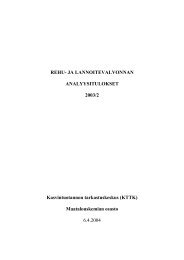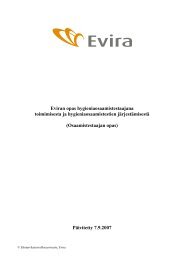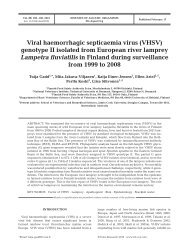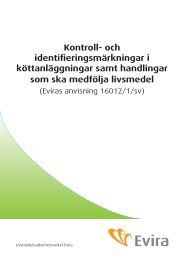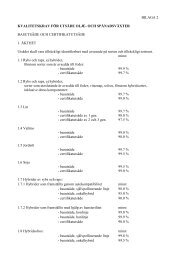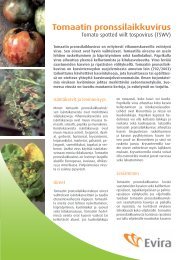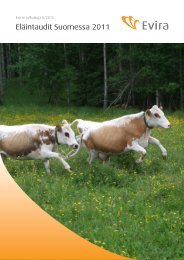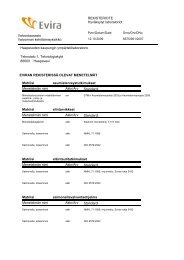Molecular characterization of endemic salmonella infections ... - Evira
Molecular characterization of endemic salmonella infections ... - Evira
Molecular characterization of endemic salmonella infections ... - Evira
Create successful ePaper yourself
Turn your PDF publications into a flip-book with our unique Google optimized e-Paper software.
2.3 Salmonella in Finland<br />
In Finland all Salmonella strains isolated from humans are sent by laboratories to the National<br />
Public Health Institute in Helsinki, Finland for verification and more accurate epidemiological<br />
classification. This practice has been voluntary from the 1960s onwards and compulsory from<br />
1994. Phagetyping <strong>of</strong> the serovars Enteritidis, Typhimurium and Paratyphi B is also carried out at<br />
the National Public Health Institute. This intitute has kept a nationwide register on infectious<br />
diseases in humans starting in 1994.<br />
Salmonellosis in humans is relatively rare in Finland: the annual incidence was 44-53 cases per<br />
100 000 inhabitants in 2000-2004, and 85 per cent <strong>of</strong> these were related to recent foreign travel.<br />
The most common serovars causing infection in humans are the serovars Enteritidis and<br />
Typhimurium. Most cases <strong>of</strong> S. Enteritidis are <strong>of</strong> foreign origin whereas the cases <strong>of</strong> S.<br />
Typhimurium are mainly (90-95%) <strong>of</strong> domestic origin. In the 1990s, an average <strong>of</strong> 350 cases per<br />
year <strong>of</strong> human salmonellosis <strong>of</strong> domestic origin caused by S. Typhimurium was recorded<br />
compared with an average 160 cases annually in 2000-2004. S. Typhimurium DT1 has been the<br />
predominant phage type except in 1997. S. Infantis is considered <strong>endemic</strong> in Finland. Of the<br />
isolations made in humans, the majority is usually considered to be <strong>of</strong> domestic origin. This<br />
especially applies to the isolations found in the 1970s and 1980s. The number <strong>of</strong> S. Infantis cases<br />
recorded in humans has decreased substantially during the 1990s; an average <strong>of</strong> 33 cases per<br />
year was recorded in 1995-1999, compared with an average only eight cases annually in 2000-<br />
2004. An increase in S. Agona <strong>infections</strong> in humans was seen in 1999, with over 80 cases <strong>of</strong><br />
infection. In the years 2000-2004, an average <strong>of</strong> 25 cases annually was recorded (National Public<br />
Health Institute 1965-1994; Ministry <strong>of</strong> Agriculture and Forestry 2000; Finnish Food Safety<br />
Authority <strong>Evira</strong> 2006).<br />
Salmonella Agona had been only sporadically isolated from animals in Finland before the small<br />
outbreaks on cattle farms in 1994-1995 and in 1997. S. Agona was not isolated in any farms in<br />
2001-2005 (Figure 1). S. Infantis was rarely [only 4% (20/480) <strong>of</strong> the Salmonella isolations in 1970]<br />
encountered among animals before the spread among broiler chickens in 1971. The latter caused<br />
an epidemic in both humans and broilers in Finland (Nurmi and Rantala 1972; Rantala 1976). S.<br />
Infantis became more common among cattle throughout Finland in the 1980s, and in the 1990s it<br />
became the predominant Salmonella serovar. In recent years, the number <strong>of</strong> S. Infantis infected<br />
farms has been five or less (Figure 1). S. Typhimurium has been relatively frequently isolated from<br />
animals ever since its recording was started in 1965. Phage typing <strong>of</strong> S. Typhimurium isolates<br />
according to the Colindale method began in March 1968. Definitive type (DT) 1 was not<br />
encountered in isolates obtained from animals before 1980. S. Typhimurium DT1 is also<br />
19



